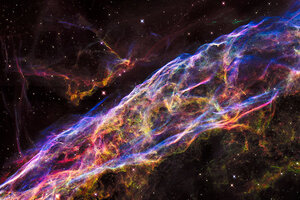Spectacular Veil Nebula images reveal celestial masterpiece
Layering NASA's Hubble Space Telescope's 18-year-old pictures of the nebula with the new ones shows how debris from an ancient star explosion are still expanding through space.

NASA's Hubble Space Telescope has unveiled in stunning detail a small section of the expanding remains of a massive star that exploded about 8,000 years ago. Called the Veil Nebula, the debris is one of the best-known supernova remnants, deriving its name from its delicate, draped filamentary structures.
NASA/ESA/Hubble Heritage Team
Images of an iridescent cloud of gases and dust still settling after a massive star explosion – a supernova – about eight millenniums ago show a breathtaking view of space thousands of light years away.
The Hubble Space Telescope, which has been orbiting the earth since 1990, has produced images of the Veil Nebula, a zoomed-in portion of what astronomers call Cygnus Loop, a donut-shaped nebula that is six times the apparent diameter of the full moon, according to NASA’s Space Telescope Science Institute in Baltimore, which makes images from Hubble available to the public.
“The problem with this object is that it’s so big in the sky, we can only look at small pieces of it at a time,” Zoltan G. Levay, who leads the institute’s imaging group, said last week in a YouTube video.
“But that’s actually kind of cool, because with Hubble’s great resolution we can see these things in great detail,” he added.
This detail of the Veil Nebula – measuring about two light-years across – shows the edges of the explosion of a star that astronomers say was 20 times bigger than our sun. The radiant light comes from the blast expanding and ultimately colliding into a spherical shell of cool, dense interstellar gas. The reddish filaments, NASA says, occur after gas is swept into the shock wave at speeds of nearly 1 million miles an hour, so fast that it could travel from Earth to the moon in 15 minutes.
The final, artistic masterpiece of a portion of the nebula hovering over a mosaic of stars was formed by combining six images taken by Hubble over 18 orbits. The telescope used highly sensitive filters to bring out the colored lights. The red comes from hydrogen; green from sulfur; blue from oxygen.
The rippled, colored shape of the interstellar cloud is formed by varying factors such as temperature, density, and when the gasses were struck by the blast's shock wave.
“We talk about this being an oxygen, a hydrogen and a sulfur picture and there are cases where we look at supernova remnants and those things are telling us about the composition of the gas being different in different places,” William P. Blair, an astrophysicist and professor at Johns Hopkins University said in the YouTube video.
He continued, “Here the gas is pretty much one composition and those different filters are telling us something about the physical conditions, the temperature and density variations, as opposed to composition of the material.”
This isn’t the first time Hubble has photographed the Veil Nebula. The last time was in 1997. Having the two sets of photos allows astronomers to study how the nebula has expanded since it was first photographed.
“The shock wave is moving rather rapidly through this material,” said Dr. Levay. “When we do compare those two observation we do see obvious motion in the material.”
The Hubble telescope was first launched by NASA and the European Space Agency above the earth’s atmosphere in 1990, having since then sent back hundreds of thousands of images that have helped astronomers determine the age of the universe, the identity of quasars, and the existence of dark energy.

